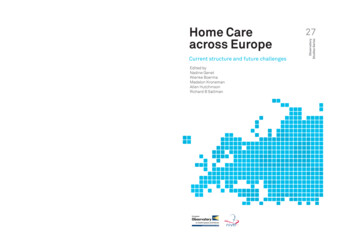
Transcription
Cover WHO nr27 8.5mm Mise en page 1 15/01/13 17:02 Page127 14Home Care across Europe probes a wide range of topics including the linkage betweensocial services and health-care systems, the prevailing funding mechanisms, howservice providers are paid, the impact of governmental regulation, and the complexroles played by informal caregivers.The editorsNadine Genet is a researcher at the Netherlands Institute for Health ServicesResearch NIVEL in Utrecht.Wienke Boerma is a senior researcher at the Netherlands Institute for HealthServices Research NIVEL in Utrecht.Allen Hutchinson is Professor in Public Health Medicine and now Emeritus Professorin the School of Health and Related Research at the University of Sheffield.Richard B Saltman is Associate Head of Research Policy at the European Observatoryon Health Systems and Policies, and Professor of Health Policy and Management atthe Rollins School of Public Health, Emory University in Atlanta.“My congratulations for this truly impressive publication. The scope of the analysisoffered in this book sets new standards and will set the mark high for future studies.”Manfred Huber, Coordinator, Healthy Ageing, Disability and Long-term Care,WHO Regional Office for Europe.Observatory Studies Series No. 27Edited by Nadine Genet, Wienke Boerma, Madelon Kroneman,Allen Hutchinson, Richard B SaltmanMadelon Kroneman is a senior researcher at the Netherlands Institute for HealthServices Research NIVEL in Utrecht.CURRENT STRUCTURE AND FUTURE CHALLENGESDrawing on a set of Europe-wide case studies (available in a second, online volume),the study provides comparable descriptive information on many aspects of theorganization, financing and provision of home care across the continent. It is a textthat will help frame the coming debate about how best to serve elderly citizens asEuropean populations age.Home Careacross EuropeCurrent structure and future challengesEdited byNadine GenetWienke BoermaMadelon KronemanAllen HutchinsonRichard B Saltman27ObservatoryStudies SeriesHOME CARE ACROSS EUROPEFor every person over the age of 65 in today’s European Union there are four people ofworking age but, by 2050, there will only be two. Demand for long-term care, of whichhome care forms a significant part, will inevitably increase in the decades to come.Despite the importance of the issue there is, however, a lack of up-to-date andcomparative information on home care in Europe. This volume attempts to fill some ofthat gap by examining current European policy on home-care services and strategies.
Home Care across Europe
The European Observatory on Health Systems and Policies supports and promotes evidencebased health policy-making through comprehensive and rigorous analysis of health systems inEurope. It brings together a wide range of policy-makers, academics and practitioners to analysetrends in health reform, drawing on experience from across Europe to illuminate policy issues.The European Observatory on Health Systems and Policies is a partnership between the WorldHealth Organization Regional Office for Europe, the Governments of Belgium, Finland, Ireland,the Netherlands, Norway, Slovenia, Spain, Sweden and the Veneto Region of Italy, the EuropeanCommission, the European Investment Bank, the World Bank, UNCAM (French NationalUnion of Health Insurance Funds), the London School of Economics and Political Science, andthe London School of Hygiene & Tropical Medicine.
Home Care across EuropeCurrent structure and future challengesEdited byNadine Genet, Wienke Boerma, Madelon Kroneman,Allen Hutchinson, Richard B. Saltman
Keywords:AGEDHEALTH OF THE ELDERLYHEALTH POLICYHEALTH SERVICES FOR THE AGEDHOME CARE SERVICES World Health Organization 2012 (acting as the host organization for, and secretariat of, the EuropeanObservatory on Health Systems and Policies)All rights reserved. The European Observatory on Health Systems and Policies welcomes requests forpermission to reproduce or translate its publications, in part or in full.Address requests about publications to: Publications, WHO Regional Office for Europe, Scherfigsvej 8,DK-2100 Copenhagen Ø, Denmark.Alternatively, complete an online request form for documentation, health information, or for permissionto quote or translate, on the Regional Office web site (http://www.euro.who.int/pubrequest).The designations employed and the presentation of the material in this publication do not imply theexpression of any opinion whatsoever on the part of the European Observatory on Health Systems andPolicies concerning the legal status of any country, territory, city or area or of its authorities, or concerningthe delimitation of its frontiers or boundaries. Dotted lines on maps represent approximate border lines forwhich there may not yet be full agreement.The mention of specific companies or of certain manufacturers’ products does not imply that they areendorsed or recommended by the European Observatory on Health Systems and Policies in preference toothers of a similar nature that are not mentioned. Errors and omissions excepted, the names of proprietaryproducts are distinguished by initial capital letters.All reasonable precautions have been taken by the European Observatory on Health Systems and Policies toverify the information contained in this publication. However, the published material is being distributedwithout warranty of any kind, either express or implied. The responsibility for the interpretation and use ofthe material lies with the reader. In no event shall the European Observatory on Health Systems and Policiesbe liable for damages arising from its use. The views expressed by authors, editors, or expert groups do notnecessarily represent the decisions or the stated policy of the European Observatory on Health Systems andPolicies or any of its partners.ISBN 978 92890 02882 978 92 890 0281 3Printed in the United KingdomCover design by M2MM2M
ContentsPrefaceviiList of tables, figures and boxesxiList of abbreviationsChapter 1 Introduction and backgroundWienke Boerma, Nadine Genet1.11.21.31.41.51.61.71.8Objective and structure of this bookChallenges of home care in EuropeDefinition of home careConceptual frameworkProblem and research questionsMethodsWhat was known about home care in EuropeWhat this book adds to the current knowledgeChapter 2 The policy perspectiveNadine Genet, Madelon Kroneman, Carlos Chiatti, László Gulácsi,Wienke Boerma2.12.22.32.4Policy challenges in the European home-care sectorGovernance by European governmentsGovernance on home-care fundingChallenges and developmentsChapter 3 Clients in focusVjenka Garms-Homolovà, Michel Naiditch, Cecilia Fagerström,Giovanni Lamura, Maria Gabriella Melchiorre, László Gulácsi,Allen Hutchinson3.13.23.33.43.5IntroductionClientsAccess to home careInformal caregivers and their role in the care processChallenges and 66
vi Home Care across EuropeChapter 4 Management of the care processNadine Genet, Allen Hutchinson, Michel Naiditch, Vjenka Garms-Homolová,Cecilia Fagerström, Maria Gabriella Melchiorre, Madelon Kroneman,Cosetta Greco4.14.24.34.44.54.64.74.8IntroductionWho provides home care?Integrated home-care deliveryHuman resourcesTelecareQuality monitoring, management and improvementChallenges and developmentsOverview and policy issuesChapter 5 Conclusions and the way forwardNadine Genet, Wienke Boerma, Madelon Kroneman, Allen Hutchinson5.15.25.35.45.55.6Appendix IComplexity of the home-care sectorTaking on the challengeSystem-tailored responses to challengesWays forward: the EU perspectiveOptions for policy-makersIn conclusionTerminologyAppendix II Case narratives 2123125
PrefaceThis book, consisting of two volumes, is the result of the EURHOMAP(Mapping Professional Home Care in Europe) study that was carried out from2008 until 2010. The project was developed and coordinated by the NetherlandsInstitute for Health Services Research in collaboration with other researchersand their institutes in European countries. All members of this partnership havecontributed to this book by gathering data and writing a chapter or reviewingthe book. Their names and affiliations are listed below.Netherlands Institute for Health Services Research (NIVEL), Utrecht, theNetherlands: Wienke Boerma, Nadine Genet, Dionne Sofia Kringos andMadelon KronemanUniversity of Sheffield, Sheffield, United Kingdom: Allen HutchinsonBlekinge Institute of Technology, School of Health Sciences, Karlskrona,Sweden: Ania Willman and Cecilia FagerströmJordi Gol Institute for Research in Primary Care (IDIAP), Barcelona, Spain:Bonaventura BolibarNational Institute of Health and Science on Ageing (INRCA), Ancona, Italy:Giovanni Lamura, Maria Gabriella Melchiorre, Cosetta Greco and CarlosChiattiCorvinus University, Budapest, Hungary: László GulácsiInstitute for Research and Information in Health Economics (IRDES), Paris,France: Michel NaiditchMedical University of Bialystok, Bialystok, Poland: Sławomir ChlabiczAlice Salomon University of Applied Sciences, Berlin, Germany: VjenkaGarms-HomolovàThe partnership is greatly indebted to the experts in each country who havecontributed to the data and information on which this study is based. Thenames and affiliations of the country experts that agreed to be mentioned arelisted with the country reports that can be found in Volume II (online only) ofthis book and on the web site (www.nivel.eu/eurhomap).
viii Home Care across EuropeAustria. Vjenka Garms-HomolovàBelgium. Michel Naiditch, Nadine Genet, Wienke BoermaBulgaria. Nadine Genet, Wienke BoermaCroatia. László Gulácsi, Vanessa BenkovicCyprus. Nadine Genet, Wienke BoermaCzech Republic. Vjenka Garms-HomolováDenmark. Cecilia Fagerström, Ania WillmanEngland. Allen HutchinsonEstonia. Kaja Polluste, Sławomir ChlabiczFinland. Nadine Genet, Wienke Boerma, Sari RissanenFrance. Michel NaiditchGermany. Vjenka Garms-HomolováGreece. Elizabeth Mestheneos, Giovanni LamuraHungary. László Gulácsi, Adrienn Ujváriné Siket, Gabriella Csillik,József BetlehemIceland. Allen HutchinsonIreland. Allen HutchinsonItaly. Maria Gabriella Melchiorre, Cosetta Greco, Maria Lucchetti,Carlos Chiatti, Giovanni LamuraLatvia. Nadine Genet, Wienke BoermaLithuania. Arvydas Seskevicius, Jurgita Grigiene, Sławomir ChlabiczLuxembourg. Nadine Genet, Wienke BoermaMalta. Joseph Troisi, Giovanni LamuraNetherlands. Nadine Genet, Wienke BoermaNorway. Cecilia Fagerström, Ania WillmanPoland. Sławomir Chlabicz, Ludmila Marcinowicz, Wieslawa MojsaPortugal. Silvina Santana, Patrícia Redondo, Nina SzczygielRomania. László Gulácsi, Livia PopescuSlovakia. Nadine Genet, Wienke BoermaSlovenia. Nadine Genet, Simona Smolej, Wienke BoermaSpain. Bonaventura Bolibar, Angels Ondiviela, Joan Carles Contel-Segura,Carme Lacasa, Anna Moleras, Joana Maria Taltavull, José Miguel Morales,Isabel BlascoSweden. Cecilia Fagerström, Ania WillmanSwitzerland. Michel Naiditch, Elisabeth Hirsch DuretThe study has been funded by the European Commission (DG SANCO).Finally, we extend our gratitude to the external reviewers of the manuscriptof this book: Chris Paley (HomeCare Europe; National Homecare Council,England) and Professor Jouke van der Zee (Faculty of Health Sciences,University of Maastricht, the Netherlands).Their critical reading and their
Preface ixsuggestions have considerably improved our text. Finally we would like tothank Jonathan North and Caroline White, as well as Peter Powell (typesetting),Jo Woodhead (editing) and Sarah Cook (proofreading).Appendix I defines the terminology used in the book. Appendix II providesthe case narratives (vignettes) that have been used as instruments in this study.The editors
List of tables, figuresand boxesTablesTable 2.1Table 2.2Table 2.3Table 2.4Table 2.5Table 2.6Table 4.1Table 4.2Table 4.3Table 4.4Table 4.5Table 4.6Table 5.1Table 5.2Fragmentation of home-care policyStrength of national governmental control over the homecare sectorOverall level of (national) governance for setting a vision,involvement in regulation and integration of home-care policyThree main types of home-care governanceNumber of home-care services receiving public fundingFunding of formal home careOwnership of home-care providers and the existence ofcompetition in 31 European countriesModels of integration for home health and social home careIntegration of home-care delivery throughout EuropeIntegration of home-care delivery with other types of careIndications for the quality of human resourcesThree broad models of quality managementChallenges in home care: responses and their possibleconsequencesTypology of home-care systems: different challenges and solutions303236384246747778818798114117FiguresFig. 1.1Fig. 1.2Fig. 1.3Fig. 1.4Fig. 2.1Preference for professional home-care and opinion onaffordability of home careOld-age dependency ratio in Europe, 2010 and 2050Self-perceived limitations in daily activities of retired peoplein EuropeConceptual frameworkHome-care expenditures as a proportion of GDP41245Innovative ways of dealing with human resource shortages8978BoxesBox 4.1
List of abbreviationsADIServizio di Assistenza Domiciliare Integrata (integrated home-care service)ADLactivities of daily livingANESM Agence nationale de l’évaluation et de la qualité des établissements et des servicessociaux et médico-sociauxCQCCare Quality CommissionEUEuropean UnionGDPgross domestic productGPgeneral practitionerIADLinstrumental activities of daily livingIGZHealth Care Inspectorate (Netherlands)NGOnongovernmental organizationNIVEL Netherlands Institute for Health Services ResearchOECD Organisation for Economic Co-operation and Development
Chapter 1Introduction andbackgroundWienke Boerma, Nadine Genet1.1 Objective and structure of this bookThe scarcity of up-to-date and comparative information on home care in Europeis in contrast to the growing size and importance of the sector. This book aims torespond to a need for this information as reflected inter alia in the 2006 PublicHealth Work Plan of the European Commission.1 No further overview hasbeen published since a study on the organization and financing of home care in15 countries published in 1996 (Hutten & Kerkstra, 1996). The EURHOMAP(Mapping Professional Home Care in Europe) project has been developed toassess aspects of the home-care sector in 31 European countries and the resultsof this study are reported in this volume. Policy-makers, academics and thoseresponsible for service delivery will find comparable descriptive information onmany aspects of the organization, financing and provision of home care acrossEurope. Formal structures are addressed as well as the reality of home care,including system failures and unmet needs.In this book, ‘home care’ refers primarily to services provided by professionalsin the homes of adult recipients, but informal care and the role of nonprofessionals in home care have not been left aside. The text will note explicitlyany reference to informal care. Likewise, the focus is not only on regulation forprofessionally provided home care but also on regulation aiming at stimulatinginformal care. The latter is likely to become increasingly important.Home care has a different meaning and purpose across countries, varyingfrom a safety net for those without relatives to a right for all citizens.Consequently, countries currently show strong differences in features such asthe role of professionals in home care; citizens’ eligibility for services; financial1 See: http://ec.europa.eu/health/programme/key documents/index en.htm#anchor3.
2 Home Care across Europeconditions; and regulatory mechanisms that steer the sector. Different historicaldevelopments have largely influenced these policy differences (Burau, Theobald& Blank, 2007). With its focus on ‘regulated’ home care, this book providesmore comprehensive coverage of home care as it is found in countries with welldeveloped home-care sectors.This volume is structured as follows. This first chapter provides an introductionto home care in its context, including social services and health-care systemsas well as demographic developments. This is followed by definitions, theconceptual framework and methods used in the study. Chapter 1 also describeswhat was known on home-care from the literature and what this study has addedto this knowledge. Chapter 2 will describe the choices European countries havemade on home-care related policies, including governmental responsibilitiesfor home care; the coherence of visions and regulation; how access to servicesis controlled and its quality assurance regulated. The chapter also describesprevailing funding mechanisms and how service providers are paid. Chapter3 focuses on clients in the context of the home-care sector, in particular oneligibility and aspects of accessibility to formal services, affordability and therole of informal caregivers. Chapter 4 explores differences in the managementof the care process, including coordination between different types of services,competition among providers and maintenance of the quality of services at theoperational level. The fifth and final chapter draws conclusions and looks aheadby considering the home-care related challenges raised throughout the bookand the responses that have been identified.Volume II (online at www.nivel.eu/eurhomap) contains structured descriptionsof the home-care sector in each of the 31 countries studied.1.2 Challenges of home care in EuropeGiven a choice between care in an institution or at home, most people wouldprefer to stay in their own home (TNS Opinion & Social, 2007). This may be amajor argument for the legitimacy of care provided at recipients’ homes but it isnot the only one. The provision of services in patients’ homes is typically morecost-effective than in institutions, particularly if available informal care is usedeffectively (Tarricone & Tsouros, 2008). Expectations about the possibilitiesfor home care have grown as new technology facilitates care coordinationand enables distant monitoring and more complex treatments in the homesituation (Tarricone & Tsouros, 2008). In many countries, the balance of longterm care tends to shift towards home-based care, as many governments pursuethe concept of ‘ageing in place’ (OECD, 2005).
Introduction and background 3In addition to these specific arguments, general arguments applicable to longterm care are also valid for home care. Health and social care systems are facinggrowing demand as a consequence of demographic and societal developmentsin most European countries (OECD, 2011). In the EU-27 at present, for everyperson over the age of 65 there are four people of working age, but by 2050there will be only two. As a consequence, demand for long-term care, includinghome care, can be expected to increase in the decades to come. If certain typesof home-care services would indeed prove more cost-effective than institutionalcare, demand for home care could grow faster as a result of substitution policies.Governments’ current role in home care is not evident. On the one hand,they are under pressure to anticipate the future by developing at least a visionon home care and taking appropriate steering measures. On the other hand,the health and social care sectors in some countries are showing a trend ofretreating governments that are giving more space to private initiatives. Inpublic opinion, however, government has a clear role in the provision of care.Europeans generally (90% or more) hold the opinion that home care andinstitutional care for elderly people should be provided by public authorities(TNS Opinion & Social, 2007). Concerning financial implications, less thanhalf (48%) think that children should be financially liable for the care of theirelderly parents if their parents’ income is not sufficient (TNS Opinion &Social, 2007). Although professional care is clearly preferred, only 34% believethat care services for dependent people in their own homes is affordable (TNSOpinion & Social, 2007). Public opinions about the first choice for help witha dependent parent and the affordability of home care vary strongly betweenEuropean countries (see Fig. 1.1).One important question is the extent to which the expectations of Europeancitizens regarding publicly financed care can be sustained in the future andwhether the relatively generous home-care schemes that exist in a number ofcountries will be sustainable in the light of the continuing economic downturn.In countries where home care has been decentralized, financial pressure in thesector may generate geographical differences and thus become a challenge toequity (Burau, Theobald & Blank, 2007).In addition to the expected growing demand and financial constraints in thehome-care sector, the availability of home-care workers is another possiblechallenge. Home care is labour intensive and the question is whether sufficientqualified staff will be available if the ratio between the working age populationand the elderly population changes as mentioned above. Scarcity also appliesto informal carers, such as spouses, children, other relatives and volunteers.In many countries informal care is becoming scarcer as a result of growingmobility, urbanization and women’s increasing participation in the labour
4 Home Care across EuropeFig. 1.1 Preference for professional home care and opinion on affordability of home carePolandLithuaniaRomaniaBulgariaCzech ndItalyLuxembourgUnited n01020304050% of respondents60708090Public or private service providers should visit their home and provide them with appropriate help a% of respondents having an opinion on the affordability of home care, agreeing that professional careat home is available at an affordable cost baData based on the question: “Imagine an elderly father or mother who lives alone and can no longer manage to live withoutregular help due to his or her physical or mental health condition. In your opinion, what would be the best option for people inthis situation?”Possible answers: moving to a nursing home; living with one of their children; children visiting to provide care; don’t know.Data based on the question “Could you please tell me if you agree or disagree with each of the following statements regardingthis issue?”bSource: TNS Opinion & Social, 2007.
Introduction and background 5market, the latter traditionally providing the lion’s share of informal care(Mestheneos & Triantafillou, 2005; Gibson, Gregory & Pandya, 2003).Conversely, the current economic crisis could have a softening effect on theworkforce problem in the care sector. In times of economic stagnation andgrowing unemployment, working in the care sector can be perceived as arelatively safe haven.The current turbulent situation in the European Union (EU) also affectsnon-EU members and so all countries are likely to be forced to reorientatetheir health and social care systems, including home-care services. Our studyfound that home care is a relatively new phenomenon in central and easternEurope. In such countries the current financial constraints are not favourablefor further development and what used to be best practices may no longer betaken automatically as models to strive for. Even countries with traditionallywell developed home-care systems are likely to be forced to look for new, moresustainable models of care provision. Probably there will be a greater need thanever before for foreign experiences and models of provision to develop newforms of care that balance quality, equity and costs and contain an optimal mixof professional and volunteer-provided care.Decision-making is extremely complex as home care is so heterogenous.It consists of care provided for the long term; for short-term recuperation afterhospital discharge; and palliative care (Genet et al., 2011). Furthermore, andthis distinction will be made throughout the book, it consists of both social andhealth care services (Burau, Theobald & Blank, 2007). The social care system ismore often organized at local level, has a lower level of professionalization and isless generously funded than the health-care system (Leichsenring et al., 2005).The home-care sector is also complex because of its interdependency withother sectors that have a role in enabling people to stay at home – for instance,the hospital sector, primary health care, housing and the social welfare sector.Coordination is essential, not just between professional care providers but alsobetween professionals and informal caregivers (Bonsang, 2009).1.2.1 Differences in the urgency and severity of challengesThe urgency and severity of challenges may vary between countries as thereare not only great differences in national wealth but also in the indicatorsof future demand for care. In 2010 the purchasing power per inhabitantdiffered by a factor of six between Luxembourg and Bulgaria (Eurostat, 2806-2011).2 Similarly, there are marked variations in expenditures on long-term2 Eurostat [online/offline database]. Luxembourg, European Commission al/statistics/themes, accessed 6 June 2012).
6 Home Care across Europecare – in eight Organisation for Economic Co-operation and Development(OECD) countries in 2008 these varied from less than 0.5% to about 3.6%of gross domestic product (GDP) (OECD, 2010). Also, the allocation of theseexpenditures to nursing and social services differed between countries. A morerelevant indicator for the target population for home care is older people’s abilityto pay for services they need. This shows extreme differences between countries.On average, 22% of the EU-27 population over 65 years old is at risk of socialexclusion or poverty (Eurostat, 15-02-2011). Bulgaria (66%), Latvia (55.5%)and Cyprus (50.1%) are far above this average. The risk of social exclusionand poverty is lowest in Luxembourg (6.2%), the Netherlands (8.1%) andthe Czech Republic (11.7%) (Eurostat, 15-02-2011). Clearly, elderly peoplein these latter countries will be in better positions to cope with measures ofincreased private payments for services.The balance between the working population and the retired populationindicates the burden of elderly care on the working population. Until 2050,the proportion of the population aged over 65 years will increase in comparisonto the population aged between 15 and 64 years. The old-age dependency ratiodiffers widely across countries (see Fig. 1.2). In countries with a high old-agedependency ratio, relatively fewer people will be available to pay for and carefor their elderly people. In 2050, the old-age dependency ratio is expected tobe relatively high in Slovenia, Italy and Spain and relatively low in Cyprus,Luxembourg and the United Kingdom (see Fig. 1.2). Between 2010 and 2050the increase in this dependency ratio will be most drastic in Ireland, Malta,Slovakia and Poland.A specific indicator for demand in the shorter term is the self-perceived severelimitations in daily activities among the elderly population. These also varybetween countries, though to a lower degree (see Fig. 1.3). Some of the highestproportions of the elderly population with severe perceived limitations arefound in Portugal, Slovakia and Greece; the lowest are found in Malta, theNetherlands and Switzerland. In countries where more elderly people perceivelimitations the need for (professional and/or informal) care may be expected tobe higher.It may be concluded that a number of (externally caused) challenges that policymakers are facing in the home-care sector have similar features across Europe.However, they are addressed in quite different national situations.
Introduction and background 7Fig. 1.2 Old-age dependency ratio in Europe, 2010 and 2050IcelandUnited aAustriaCzech 0102030405060%20102050Note: The old-age dependency ratio is the projected number of people aged 65 and over expressed as a percentage of theprojected number of people aged between 15 and 64 (Eurostat, last updated: 17–06–2011).
8 Home Care across EuropeFig. 1.3 Self-perceived limitations in daily activitiesa of retired people in ited iaSwedenCzech etherlandsMalta010203040506070% of total retired populationSeverely hampered bHampered to some extent cacRestriction of activity for at least the past 6 months – in 2009; b Limited due to health problems, but not strongly;Strongly limited due to health problemsSource: Eurostat, last updated 22-02-2011.80
Introduction and background 91.3 Definition of home careThis study showed that the term ‘home care’ is understood very differentlyacross countries and sectors. The services included vary considerably amongcountries and even ‘home’ turns out to be an elastic term. Many studies onhome care lack precision in defining the activities, goals and even the targetgroups of home care (Thomé, Dykes & Hallberg, 2003; Breedveld, 2004).Home care can be conceived of as any care provided behind someone’s frontdoor or, more generally, referring to services enabling people to stay living intheir home environment. In some countries, ‘someone’s front door’ can includea home for the elderly. As regards the type of services, home care may refer tocare given only by professionals or in combination with care given by a spouseor relative (personal care or housekeeping).The EURHOMAP study has defined home care as care prov
on Health Systems and Policies, and Professor of Health Policy and Management at the Rollins School of Public Health, Emory University in Atlanta. “My congratulations for this truly impressive publication. The scope of the analysis o ffered in this book sets new










